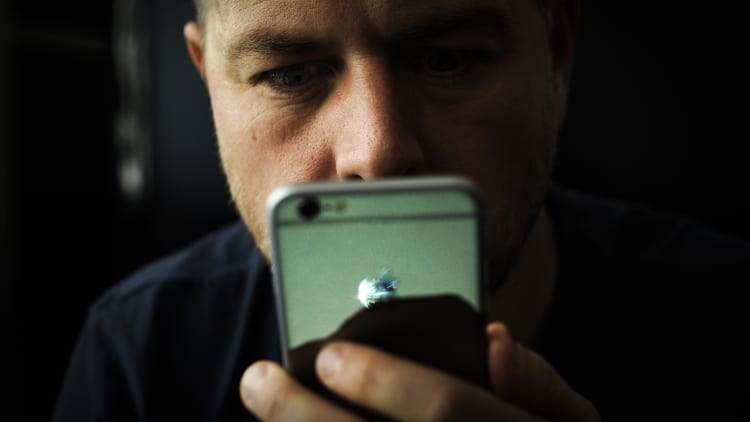In a single day, we'll touch our smartphones 2,617 times, check email 74 times, and receive 46 notifications, research firm Dscout found. We'll spend more than three hours on our phones and tablets, 40 minutes on our home computer, and almost five hours watching TV each day, according to Nielsen.
Altogether, that means we're spending about half of our waking day looking at one of our personal devices, not counting the time we spend on screens for our job.
And that's if we're a light user. People who really love their smartphones touch them 5,427 times a day, adding up to more than 225 minutes a day, or almost four hours just on that one device alone, Dscout found.
But our continually growing usage and dependency on smart devices may need a rethink.
Research suggests that the more time we spent on our screens the less happy we feel and that may increase our odds of developing mental health issues such as anxiety and depression. While the exact impact remains a hotly debated topic, 54% of teens and 36% of parents admit feeling like they spend too much time on their cellphones, a survey from the Pew Research Center found.
Likely because even if they aren't feeling a negative mental toll, they are noticing that all their free time keeps disappearing and they can't leave their phone for five minutes.
"What's making people uncomfortable is this feeling of losing control. Their sense of autonomy is being diminished. We've allowed our phones to change what we pay attention to, to actually take us away from the things we really care about as opposed to making those experiences richer," says Georgetown computer science professor and best-selling author Cal Newport.
But cutting back on our screen time can be incredibly hard.
"People don't succumb to screens because they're lazy, but instead because billions of dollars have been invested to make this outcome inevitable," says Newport. He spoke with CNBC Make It about how to break that cycle — or at least cut back.
How to step back from your smart devices
The only way to fight back, Newport argues in his new book "Digital Minimalism: Choosing a Focused Life in a Noisy World," is to rethink your entire digital life and start over.
"You've got to rip off the Band-Aid. Making small tweaks won't get the job done," he says.
Fixes like abstaining from your phone for a weekend or marking certain periods as phone-free hours each night can be useful, but won't address the root of the problem.
"Gradually changing your habits one at a time doesn't work well — the engineered attraction of the attention economy, combined with the friction of convenience, will diminish your inertia until you backslide toward where you started," Newport writes in his book.
Instead a dramatic and rapid transformation is necessary.
"You've got to start from scratch and wipe the slate clean of all these apps and services," says Newport. "Then rebuild your collection much more carefully, so that your digital life serves only the things you really care about."
Newport has labelled this process a "digital declutter." It involves three key steps:
1. Take a 30-day break from all unnecessary technologies in your life. No, you can't use this as an excuse to get out of checking slack or email on your work computer. But if you regularly, aimlessly scroll Instagram or Facebook, this is the time to pause that practice.
2. Identify activities you want to fill your newfound time with so you don't pull that phone out. Maybe there is a stack of book you've been meaning to read, maybe you want to spend more quality time with your family, maybe you want to get back into painting or running or woodworking?
3. At the end of the break, reintroduce the technologies and apps that support something you deeply value. Create a user manual of sorts for yourself about how you will specifically use each app so you don't get pulled back into old habits. One artist who went through the process told Newport that he decided to limit the people he followed on Instagram to only other artists whose work inspired him and check it once a week, on Sunday mornings.
"When you step away from every bit of optional technology, you can then become reacquainted with what actually matters to you, with the things you actually want to spend your time on," says Newport.
Your devices will try to win you back
The simplicity of the process belies how difficult it can actually be. Newport has guided more than 600 people through this digital declutter and says many people fail to change their screen habits largely because of a few common pitfalls.
"One reason some failed was this notion of a digital detox," says Newport. "They thought of it as just taking a brief break from technology before going right back to the same behaviors that led them to want a break in the first place. Obviously, people who thought of the declutter this way did not see much lasting change."
People who shorten the break also struggled.
"Taking a whole month actually has a detoxifying effect. It takes a few weeks for you to no longer feel the strong compulsion to pull out your phone and tap on things. You have to give yourself time to actually get out of the habit of constantly interacting with the screen," says Newport.
The 30-day break also gives you time to discover how you want to fill the minutes you used to give to the screen.
"You really have to be in touch with how you want to be spending your time otherwise you won't know which digital tools to add back in and for what purpose," says Newport. "If you avoid the self-reflection and the experimentation of activities, if you don't try to find ways to fill your time pretty aggressively to see what sticks and what doesn't, you won't have a clear understanding at the end of the 30 days of what you want."
And finally, he says people grapple with deciding what apps and other technologies to allow back into their lives.
'It's the trickiest part," says Newport. "But the key question to ask isn't 'Is this app or tool useful?' but 'Is it the best way to use technology to support this thing I value?'. That superlative is crucial because every technology out there has a benefit, has some reason why you might want to use it. It's a really hard question and it's difficult to get right at first, so I always tell people do the best you can and just continue to think critically about it."
If you're worried about FOMO when you disconnect, Newport says to remind yourself of what you're gaining.
"This notion that there might be something I don't even know about yet that might be a little bit valuable to me that I could miss out on if I'm not constantly connected, ironically, leads to us losing a lot of value in our lives," says Newport. "It is almost always better to take your limited time and energy and invest it heavily into a small number of things that you know for sure bring you great satisfaction."
Like this story? Subscribe to CNBC Make It on YouTube!
Don't miss: How Gen Zers can overcome their biggest career challenge, according to best-selling author Cal Newport




